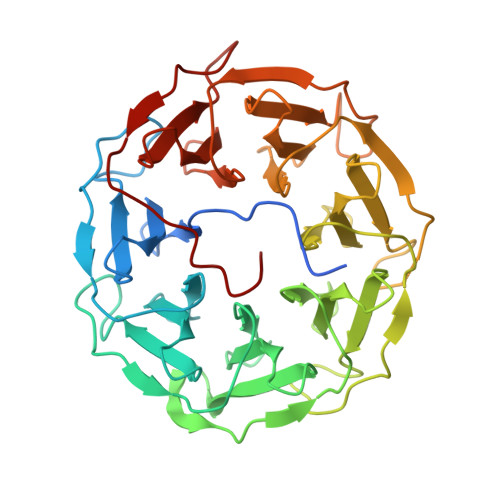Fucosylated inhibitors of recently identified bangle lectin from Photorhabdus asymbiotica.
Paulikova, G., Houser, J., Kasakova, M., Oroszova, B., Bertolotti, B., Parkan, K., Moravcova, J., Wimmerova, M.(2019) Sci Rep 9: 14904-14904
- PubMed: 31624296
- DOI: https://doi.org/10.1038/s41598-019-51357-9
- Primary Citation of Related Structures:
6FHX, 6FHY, 6FLU - PubMed Abstract:
A recently described bangle lectin (PHL) from the bacterium Photorhabdus asymbiotica was identified as a mainly fucose-binding protein that could play an important role in the host-pathogen interaction and in the modulation of host immune response. Structural studies showed that PHL is a homo-dimer that contains up to seven L-fucose-specific binding sites per monomer. For these reasons, potential ligands of the PHL lectin: α-L-fucopyranosyl-containing mono-, di-, tetra-, hexa- and dodecavalent ligands were tested. Two types of polyvalent structures were investigated - calix[4]arenes and dendrimers. The shared feature of all these structures was a C-glycosidic bond instead of the more common but physiologically unstable O-glycosidic bond. The inhibition potential of the tested structures was assessed using different techniques - hemagglutination, surface plasmon resonance, isothermal titration calorimetry, and cell cross-linking. All the ligands proved to be better than free L-fucose. The most active hexavalent dendrimer exhibited affinity three orders of magnitude higher than that of standard L-fucose. To determine the binding mode of some ligands, crystal complex PHL/fucosides 2 - 4 were prepared and studied using X-ray crystallography. The electron density in complexes proved the presence of the compounds in 6 out of 7 fucose-binding sites.
- Central European Institute of Technology, Masaryk University, Brno, Czech Republic.
Organizational Affiliation:



















